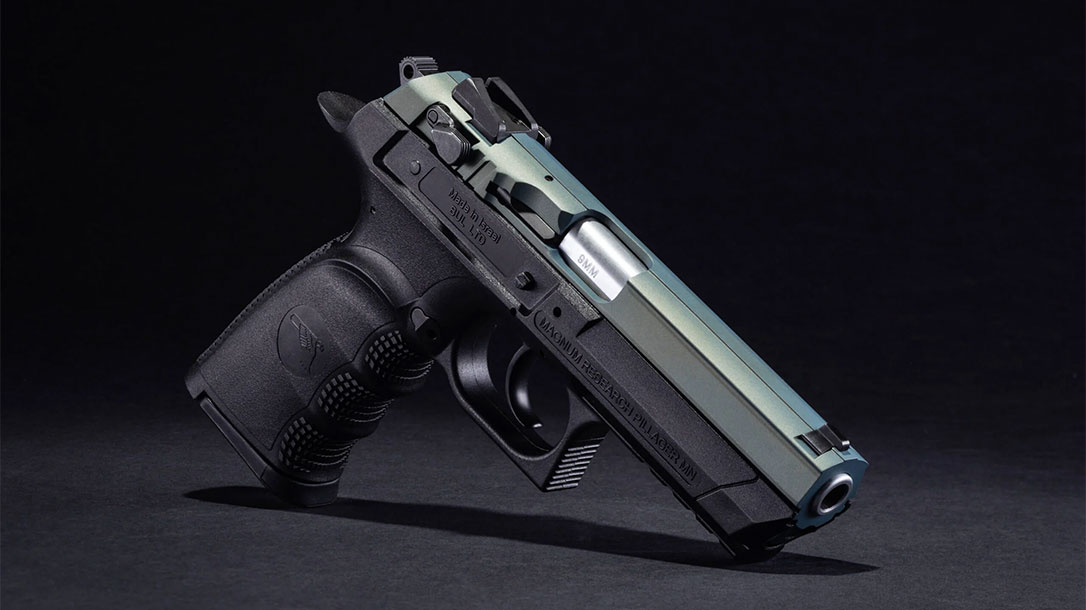Although it doesn’t share its lineage with the Desert Eagle, the Baby Eagle III (below) first hit the market in 2016. Tracing its heritage back to the Jericho pistol from the 1980s, the slim handgun delivers double-stack 10-, 12-, and 15-round capacity. Originally only offered in black, the latest release features the new Northern Lights Cerakote finish.
Magnum Research Baby Desert Eagle III Now Available with New Northern Lights Cerakote Finish
The Northern Lights finish is inspired by the aurora borealis, providing a beautiful new look for the iconic Baby Eagle. In addition, the finish is made of durable Ceraote, making it both functional and attractive. However, the new Northern Lights model is available in the polymer frame, .40 S&W or 9mm option only.
Offered in both full-size and semi-compact models, the carbon steel slide houses a 4.43- or 3.85-inch match-grade barrel. Chambered in either .40 S&W or 9mm, the barrel rifling is right-hand twist, 6 lands and grooves. Correspondingly, the slimmer slide and frame help to provide a lighter weight than previous Baby Eagle II models.
Advertisement — Continue Reading Below

Riding atop the slide are fixed combat-type, white, three-dot sights. Likewise, an ambidextrous teardrop-shaped decocking mechanism on the slide provides right- or left-handed operation. Similarly, the reversible magazine catch also provides ambidextrous engagement.
Delivering a capacity of 15 rounds for 9mm and 12 rounds for .40 S&W, each Baby Eagle III ships with two magazines. Rounds are sent downrange via the DA/SA trigger with smooth 12-pound pull in double action and 4-pounds in single action.
Advertisement — Continue Reading Below
Availability
The Magnum Research Baby Eagle III is available now with an MSRP of $739.00. For more info, please visit MagnumResearch.com.
Magnum Research Baby Eagle III Specs
| Caliber | .40 S&W, 9 MM |
| Barrel | 4.43” (Full Size), 3.85” (Semi-Compact) |
| Overall Length | 8.5”, 7.875” |
| Height | 5.65” |
| Slide Width | 1.1” |
| Weight | 2 lbs, 1.76 lbs, 1.65 lbs, 1.62 lbs |
| Trigger Pull Weight | 12 lbs. (DA) | 4 lbs. (SA) |
| Sights | Combat type, White three dot, Fixed |
| Finish | Black Polymer Frame and Black Oxide Slide | Black Polymer Frame and Northern Lights Cerakote finish Slide |
| Magazine Capacity | 10 rounds, 12 rounds, 15 rounds |
| MSRP | $739.00 |

Advertisement — Continue Reading Below
On October 21, 2016, Dennis Adler reported:
The most amazing thing about polymer is that you can shape it anyway you want. Imagine trying to contour pistol grips and frames from steel. Actually, you don’t have to imagine it, as it has been done for decades. It just takes more time and costs more money to do. Polymer frames were originally developed by Heckler & Koch in 1970 for the VP70. This was more than a decade before Gaston Glock took the polymer frame from near obscurity and turned it into one of the most successful handgun designs of the 20th century.
Today, it’s more likely that a new handgun will have a polymer frame than one made of alloy or steel. For the Baby Desert Eagle, now in its third iteration, polymer has allowed this classic Israeli version of the CZ 75 to soar to new heights with a lighter carry weight and a new grip frame design.
Icon Reborn

Advertisement — Continue Reading Below
Among the many variations of the Ceská Zbrojovka design, the Baby Desert Eagle is best remembered for its second version. It was a specially built, Israeli-manufactured CZ 75 BD. The Baby Desert Eagle II and the new Baby Desert Eagle III’s internal design and operation are essentially the same. Specifically, they are based entirely on the CZ—a short recoil-operated, locked-breech design.
A CZ at Heart
Although the exterior is reconfigured to resemble the big .44 and .50 AE Desert Eagles, the Baby Desert Eagle III remains a CZ at heart. It’s a single-action/double-action, single-stack variant chambered in either 9mm, .40 S&W or .45 ACP. In all other respects it is the Ceská Zbrojovka design introduced in 1976 and improved with the addition of a firing pin block in the late 1980s (CZ 75 B) and the addition of a decocking lever (CZ 75 BD), which was also used on the Baby Desert Eagle II. What is most significant about that feature on the Baby Desert Eagle III is that the shape of the ambidextrous safety/decocker has been changed to provide not only easier operation, but also a very solid (albeit roughly textured) grasping surface for racking the slide.

Advertisement — Continue Reading Below
This is noteworthy because, like all CZ 75 designs, the slide is shallow and rides inside the frame rails. This allows for a very tight slide-to-frame fit, solid barrel lockup and more consistent accuracy, a CZ 75 design trait inspired by the c.1947 Sig P210, a pistol still regarded as one of the most accurate handguns in the world. The Baby Desert Eagle III, its predecessor, and all other CZ 75-based models, such as the Jericho, the Canik TP-9V2, the TriStar T-120 and the Swiss-built Sphinx SDP Compact, are all distinguished by this characteristic. Not all, however, have the ambidextrous safety/decocker, nor do they have the Desert Eagle’s barrel and dust cover configuration.
The CZ design endows the Baby Desert Eagle III with excellent balance, a proven double-action/single-action trigger (and thus second-strike capability) and the decocker (pushing either ambidextrous safety lever downward automatically decocks the Baby Desert Eagle III and engages its internal safeties).
Disassembly and Cleaning
Finally, the CZ 75 design remains one of the easiest designs to field-strip for cleaning. As important as ease of operation is the ease in which a gun can be taken down in the field for cleaning or to address a mechanical malfunction. With the magazine removed and the chamber cleared, all the user needs to do is cock the hammer and move the slide back 0.1875 inches, thereby aligning two registration marks (one on the rear of the slide, one on the frame) and pull out the slide release lever. The slide slips off the frame and the recoil spring, guide rod and barrel are easily removed. Another small but noteworthy feature is the back of the guide rod. It has a registration pin that locks into the barrel lug, keeping it firmly in place for reassembly.
Advertisement — Continue Reading Below
Polymer Powerhouse

As Magnum Research celebrates its 30th anniversary in 2016, the company has introduced three new 9mm versions of the polymer Baby Desert Eagle III, the Full Size model with a 4.43-inch barrel, a Semi-Compact with a 3.93-inch barrel and a Compact variant with a 3.64-inch barrel. In .40 S&W, there are two polymer-framed versions, the Full Size model I tested and the Semi-Compact. The new .45 ACP model is currently only offered on the steel-frame platform.
The advantage of a polymer frame, other than weight savings, is the distinctive grip design. The polymer models have a fully contoured grip with deeply molded checkering on the backstrap, a slightly deeper beavertail and a finger-grooved, checkered, combat-style frontstrap. This gives the polymer Baby Desert Eagle III superb stability in the hand, especially with the higher-velocity .40 S&W chambering. In all other respects, the undercut triggerguard and the relationship of the slide and magazine releases are identical to the steel-framed models.
Advertisement — Continue Reading Below
Carrying the Baby Eagle III
With an overall length of 8.38 inches, a width of 1.53 inches, a height of 5.75 inches and a weight of just 28 ounces unloaded, this is one of the easiest full-sized handguns to carry concealed. The Semi-Compact model is 0.55 inches shorter in overall length and 3 ounces lighter, though both models offer a very respectable 12+1 capacity in .40 S&W.
The imperative with any CZ-platform pistol, the Baby Desert Eagle III included, is how the gun is put together and the materials that are used. That is what can, and often does, separate the various CZ 75 designs from one another. A CZ 75 pistol can cost as little as $459 or as much as $1,295, but the Full Size Baby Desert Eagle III in .40 S&W carries a very affordable MSRP of just $646.
Range Time

Advertisement — Continue Reading Below
I tested the Baby Desert Eagle III using three different brands of tactical ammunition. This included Hornady’s American Gunner 180-grain XTP, Federal’s Hydra-Shok 180-grain JHP and Sig Sauer’s Elite Performance V-Crown 165-grain JHP. All three were consistently accurate with the test gun, delivering average groups of 2 inches or less from 15 yards. The Hornady load clocked a 1,005 fps average through a ProChrono chronograph for the slowest velocity, but this is incremental, while the Federal Premium load traveled downrange at 1,010 fps. The lighter Sig Sauer V-Crown load had the highest average velocity of 1,054 fps.
The best five-round group, which measured 1 inch with two shots overlapping, was scored with the Federal load. The Sig Sauer ammo opened up by a mere 0.20 inches, while Hornady delivered its best five rounds at 1.99 inches. All hits were inside the 9, 10 and X rings at point of aim. The pistol’s white-dot sights are quick to pick up, recoil is more than manageable for a .40 S&W and the gun is quick to get back on target. When fired in single action, the trigger’s take-up is 0.375 inches with minimal stacking and zero overtravel.
The Takeaway

I have always liked the CZ 75 design and the entire line of Baby Desert Eagle pistols. What the polymer-framed models bring to the table is a lighter carry weight without sacrificing recoil management; a superior grip design; ease of operation and the advantages of single- and double-action firing; a decocking, hammer-fired action; and excellent, low-profile white-dot sights. It is simply the best Baby Desert Eagle yet, or perhaps the best CZ 75 yet. Take your pick.
For more information, visit http://www.magnumresearch.com or call 508-635-4273.
This article was published in ‘Concealed Carry Handguns’ 2016. For information on how to subscribe, please email subscriptions@
























